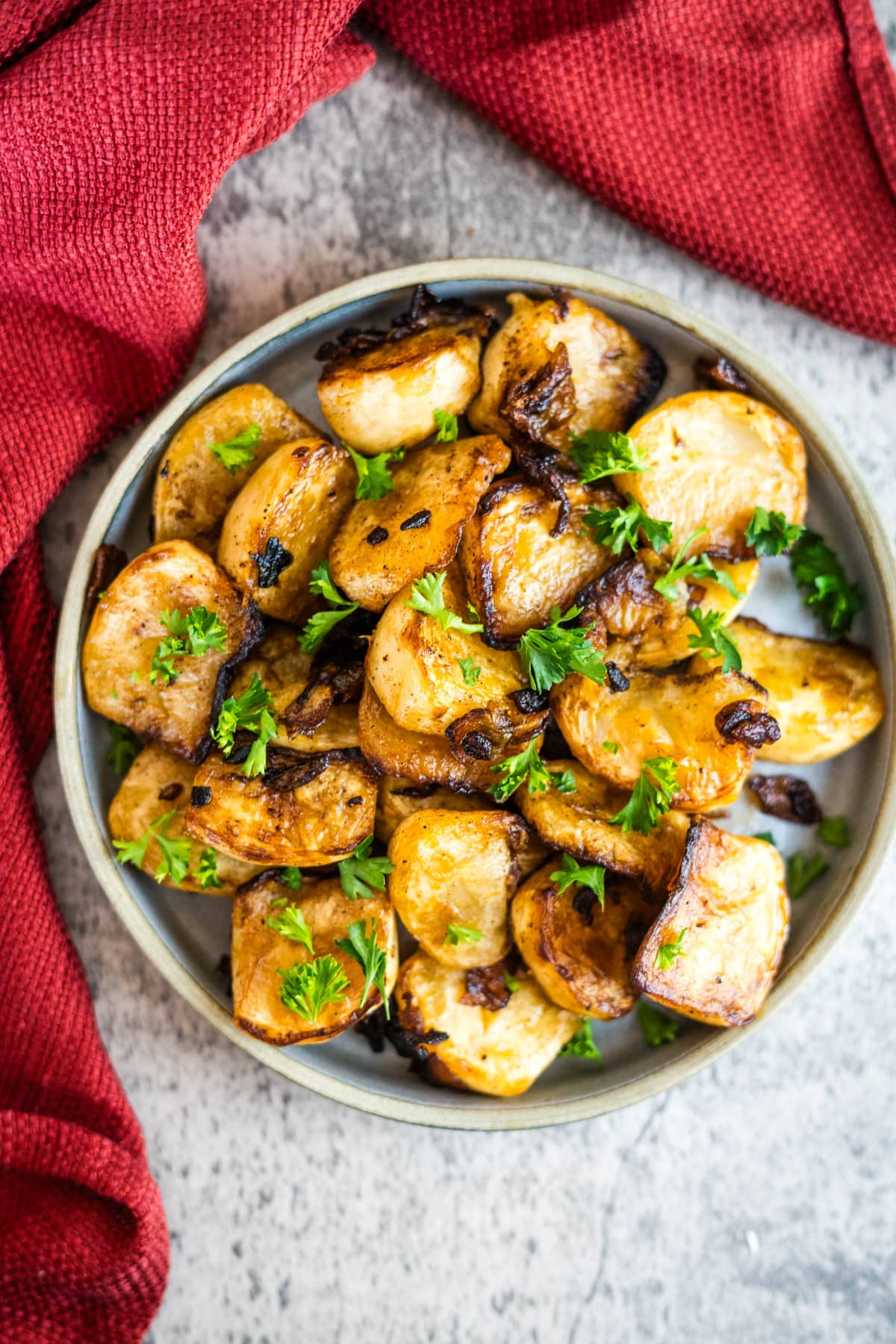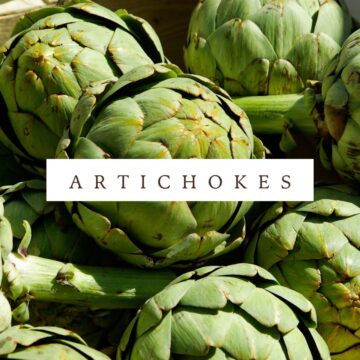Turnips, often overlooked, are a versatile root vegetable with a lot to offer in the kitchen. In this article, we'll take a closer look at turnips, their types, cultivation, and how they can enhance your culinary creations. Whether you're an experienced chef or just curious about turnips, join us in uncovering the culinary potential of this unassuming yet remarkable vegetable.
Jump to:
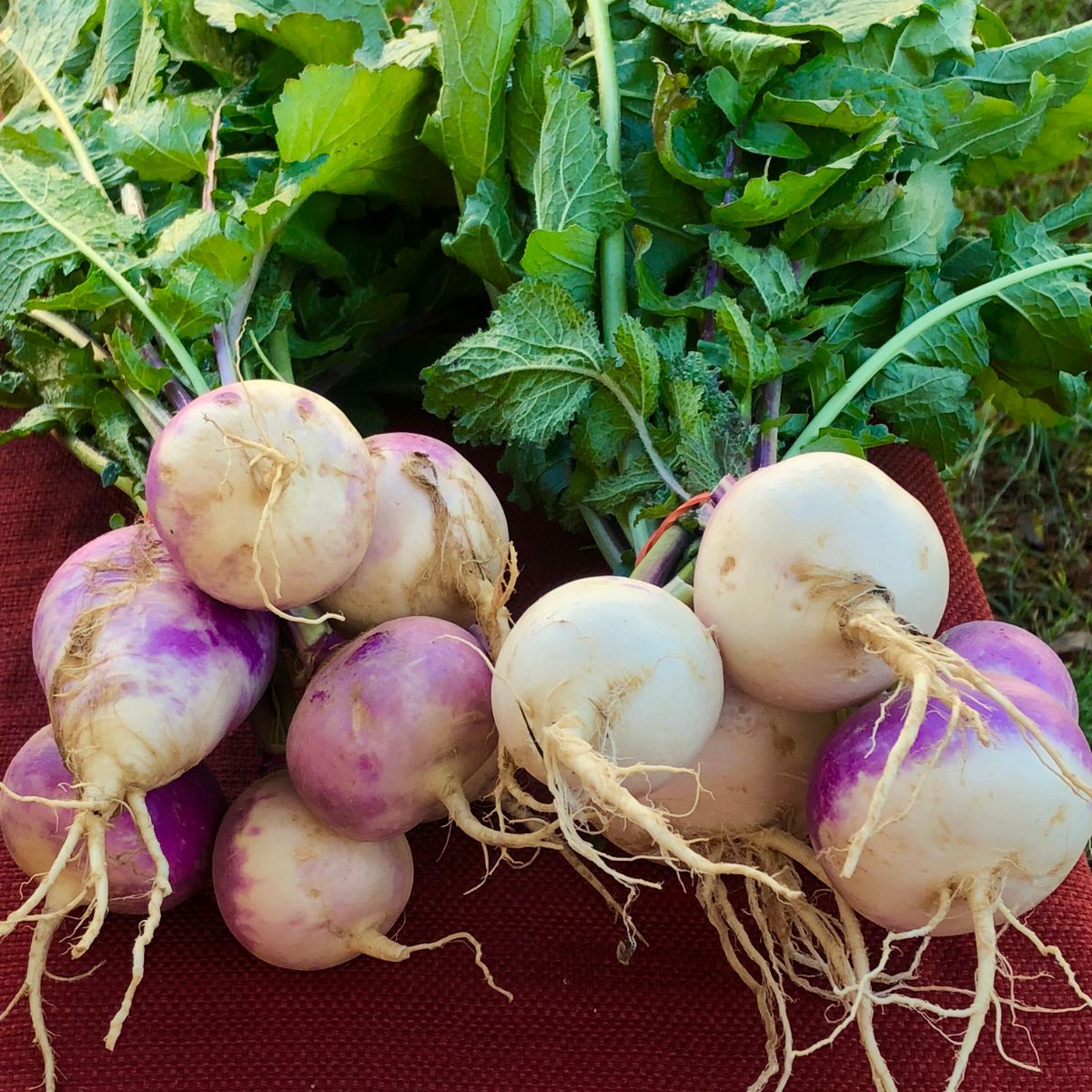
Turnip Interesting Facts
Did you know about these turnip facts?
- Ancient Roots: Turnips have a long history, dating back thousands of years. They were cultivated in ancient Greece and Rome and were a staple crop in Europe during the Middle Ages.
- Versatile Vegetable: Turnips are incredibly versatile in the kitchen. You can enjoy them raw in salads, pickled, boiled, roasted, mashed, or even used as a low-carb alternative to potatoes in various dishes.
- Dual Delight: While turnips are primarily grown for their roots, their leafy greens, known as turnip greens or turnip tops, are also edible and nutritious. They offer a different set of flavors and nutrients compared to the root.
- Winter Survivor: Turnips are a cool-season crop and can tolerate frost. This resilience allows them to thrive in colder climates and remain available during the winter months.
- Variety Matters: There are numerous varieties of turnips, each with its own unique characteristics. Some are known for their sweet, mild flavor, while others have a slightly peppery or nutty taste. Varieties also differ in size, shape, and color.
- Heirloom Heritage: Many regions have their own heirloom turnip varieties, which have been passed down through generations. These heirloom turnips often have distinct flavors and cultural significance.
- Companion Plant: Turnips are often used as companion plants in gardening. They can help repel certain pests and provide ground cover to protect the soil.
- Symbol of Prosperity: In some cultures, turnips have been associated with good luck and prosperity. In Scotland, for example, they were traditionally carved into lanterns for New Year's celebrations.
- Global Appeal: Turnips are used in a wide range of cuisines worldwide. From Japanese pickled turnips (known as "tsukemono") to the classic British dish of "neeps and tatties" (turnips and potatoes), they have a global culinary presence.
- Low in Calories: Turnips are an excellent choice for those looking to reduce their calorie intake while still enjoying a hearty, filling vegetable. A 100-gram serving of turnips contains only about 28 calories.
- Storage Champions: Turnips have a long shelf life when stored properly. Kept in a cool, dry place, they can last for several months.
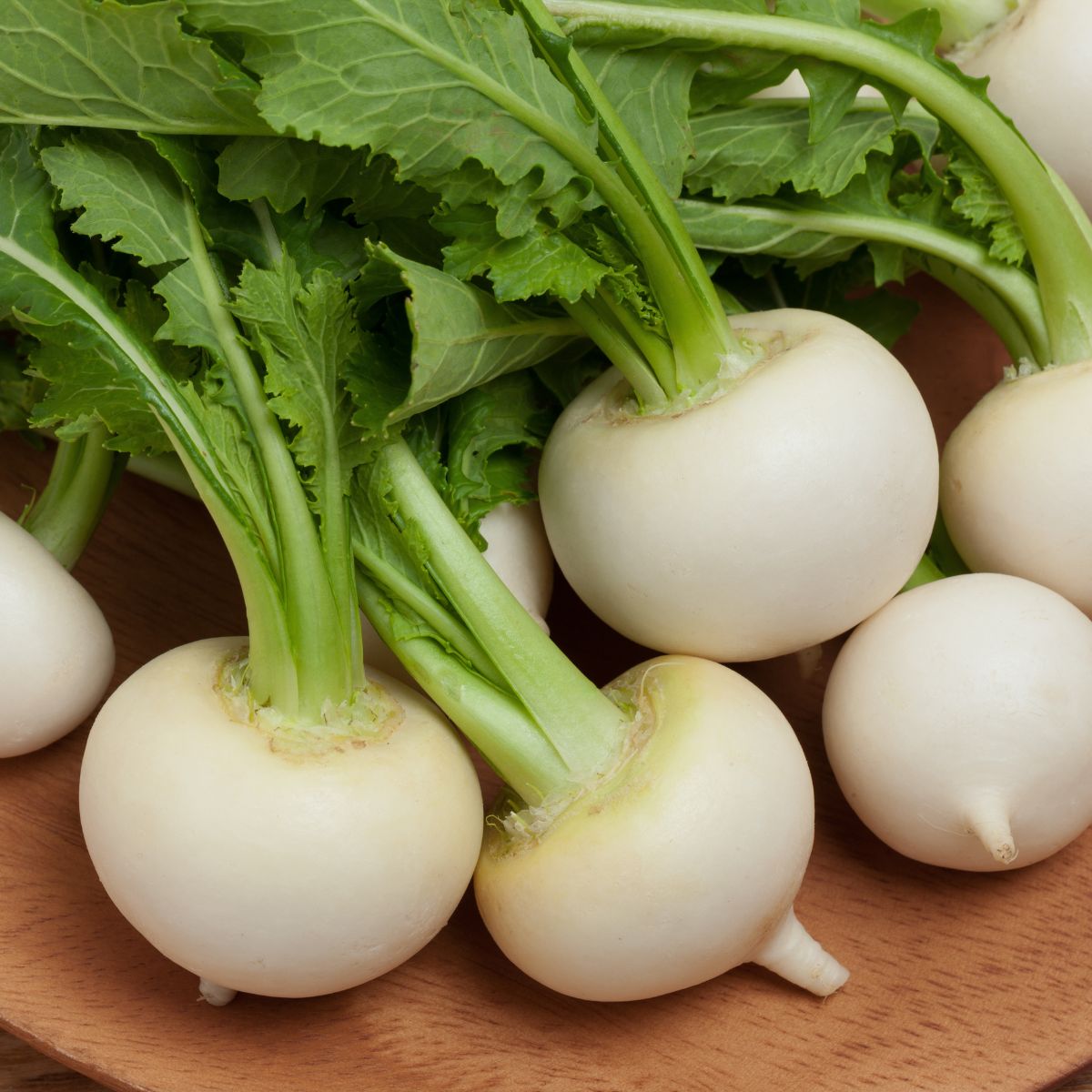
Turnip Health Benefits
Turnips offer a range of health benefits due to their nutritional profile and unique compounds. Here are some of the key health benefits of incorporating turnips into your diet:
- Low in Calories: Turnips are low in calories, making them an excellent choice for those looking to manage their weight. A 100-gram serving of cooked turnips contains only about 28 calories.
- Rich in Fiber: Turnips are a good source of dietary fiber, which promotes digestive health by preventing constipation and supporting regular bowel movements. Fiber also helps maintain a feeling of fullness, aiding in weight management.
- High in Vitamins: Turnips are a rich source of several essential vitamins, including vitamin C, which boosts the immune system and promotes healthy skin. They also contain vitamin K, important for blood clotting and bone health.
- Antioxidant Properties: Turnips contain antioxidants such as vitamin C and beta-carotene, which help combat oxidative stress in the body and reduce the risk of chronic diseases, including certain cancers.
- Mineral Content: Turnips provide essential minerals like potassium, which plays a crucial role in regulating blood pressure and maintaining heart health. They also contain calcium and magnesium, important for bone health and muscle function.
- Cancer Prevention: Some studies suggest that the compounds found in cruciferous vegetables like turnips, including glucosinolates, may have anti-cancer properties. These compounds are thought to help protect against certain types of cancer, including lung, colon, and breast cancer.
- Heart Health: The fiber and potassium in turnips contribute to heart health by reducing the risk of high blood pressure and supporting overall cardiovascular function.
- Digestive Health: Turnips are a good source of prebiotic fiber, which feeds beneficial gut bacteria and promotes a healthy gut microbiome. A balanced gut microbiome is associated with improved digestion and better overall health.
- Bone Health: Turnips contain calcium, which is essential for strong bones and teeth. Additionally, vitamin K in turnips plays a role in bone mineralization.
- Anti-Inflammatory: Some studies suggest that certain compounds in turnips may have anti-inflammatory properties, potentially reducing the risk of chronic inflammation-related diseases.
- Hydration: Turnips have a high water content, which contributes to overall hydration and helps maintain healthy skin.
It's important to note that the health benefits of turnips can be maximized when they are part of a balanced and varied diet. Incorporating turnips along with other colorful vegetables can provide a wide range of nutrients and compounds that support overall well-being.
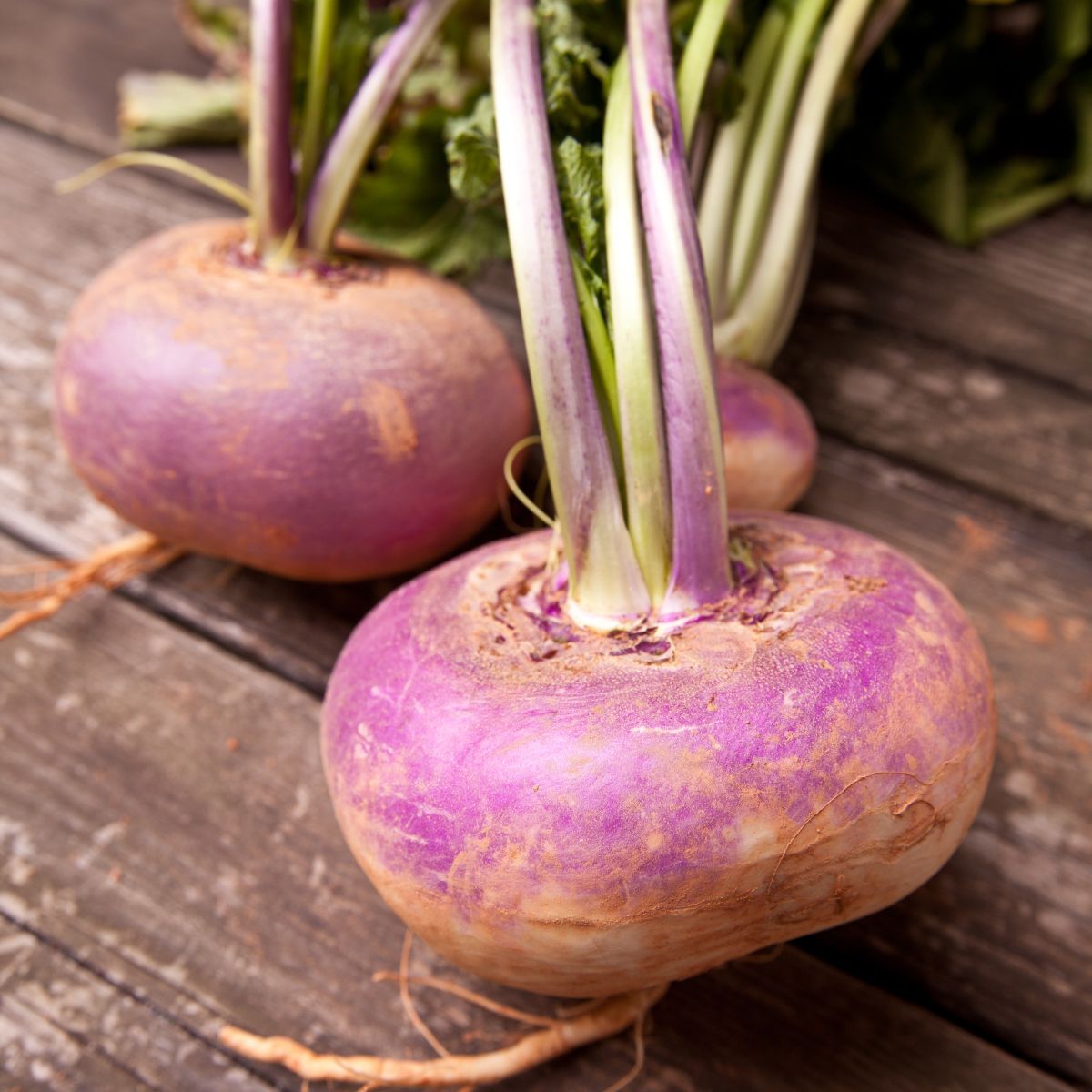
Turnip Nutritional Information
Incorporating turnips into your diet can contribute to your overall nutrient intake while keeping calorie and fat intake low. They are a healthy addition to various dishes and can be prepared in a variety of ways, from roasting and mashing to steaming and enjoying them raw in salads.
- Low-Calorie: Turnips are a low-calorie food, making them an excellent choice for those looking to manage their weight. A 100-gram serving of raw turnips contains just about 28 calories.
- Carbohydrates: Turnips are primarily composed of carbohydrates, with a 100-gram serving containing approximately 6.4 grams of carbs. The majority of these carbs come from sugars and dietary fiber.
- Dietary Fiber: Turnips are a good source of dietary fiber, providing about 1.8 grams per 100-gram serving. Dietary fiber supports digestive health by promoting regular bowel movements and preventing constipation. It also helps maintain a feeling of fullness, aiding in weight management.
- Protein: Turnips contain a modest amount of protein, with approximately 0.9 grams per 100 grams. While not a significant source of protein, turnips contribute to overall protein intake in a balanced diet.
- Fat: Turnips are very low in fat, with only about 0.2 grams per 100-gram serving. This makes them a suitable choice for those watching their fat intake.
- Vitamin C: Turnips are a good source of vitamin C, providing around 21 milligrams per 100-gram serving. Vitamin C is an antioxidant that supports the immune system, promotes healthy skin, and helps the body absorb iron from plant-based foods.
- Vitamin K: Turnips are particularly rich in vitamin K, containing approximately 0.1 milligrams per 100 grams. Vitamin K is essential for blood clotting and bone health.
- Folate: Turnips provide a small amount of folate (vitamin B9), with about 15 micrograms per 100-gram serving. Folate is important for cell division and DNA synthesis.
- Potassium: Turnips contain potassium, an essential mineral that helps regulate blood pressure and maintain proper heart and muscle function. A 100-gram serving typically provides around 191 milligrams of potassium.
- Calcium: Turnips offer a modest amount of calcium, with approximately 30 milligrams per 100 grams. Calcium is vital for strong bones and teeth.
- Magnesium: Magnesium, an essential mineral for muscle and nerve function, is present in turnips, albeit in relatively small amounts (around 11 milligrams per 100 grams).
Carbs in Turnips
Turnips are relatively low in carbohydrates, making them a good choice for those looking to manage their carb intake. Here's an approximate breakdown of the carbohydrate content in turnips:
- Total Carbohydrates in Raw Turnips:
- Approximately 6.4 grams of carbohydrates per 100 grams of raw turnips.
It's important to note that the carbohydrate content may vary slightly depending on factors such as the specific variety of turnip and its size. Despite their carbohydrate content, turnips are considered a low-carb vegetable and can be included in various low-carb or keto-friendly diets.

Types of Turnips
There are several types of turnips, each with its unique characteristics and culinary uses. Here are some common types of turnips:
- Purple Top Turnip: This is one of the most widely recognized turnip varieties. It has a purple-colored upper section, which fades into white towards the bottom. Purple top turnips have a mild flavor and are versatile for cooking and eating both the root and greens.
- Tokyo Cross Turnip: These are small, round turnips with a white, smooth skin and a sweet, mild flavor. They are often eaten raw in salads or as a crunchy snack.
- Hakurei Turnip: Similar to Tokyo Cross turnips, Hakurei turnips are small and round with a white skin. They are known for their crisp texture and sweet, nutty flavor. They are delicious when eaten raw or lightly cooked.
- Scarlet Queen Turnip: These turnips have a reddish-purple skin and sweet, tender flesh. They are often enjoyed for their vibrant color and mild flavor, making them suitable for salads and roasting.
- Golden Globe Turnip: As the name suggests, these turnips are round and have a golden-yellow skin. They have a slightly sweeter flavor than white turnips and are excellent for roasting and mashing.
- Seven Top Turnip Greens: While not grown for their roots, Seven Top turnips are primarily cultivated for their nutritious and flavorful leafy greens. The greens are tender and commonly used in Southern cooking.
- White Lady Turnip: These are small, round turnips with a smooth white skin. They have a mild, sweet flavor and are suitable for various cooking methods, including roasting and mashing.
- Purple Globe Turnip: These turnips have a deep purple skin and a white interior. They are known for their slightly peppery flavor and can be used in various dishes, including soups and stews.
- Gilfeather Turnip: A unique heirloom variety, Gilfeather turnips have a creamy white skin and a sweet, nutty flavor. They are often associated with Vermont and are ideal for roasting and making turnip-based dishes.
- Oasis Turnip: Oasis turnips are medium-sized with a creamy white exterior. They have a mild, sweet flavor and are versatile for cooking and eating raw.
How to Store Turnips
Proper storage is essential to keep turnips fresh and extend their shelf life. Here's how to store turnips effectively:
- Remove Greens: If your turnips come with the greens (turnip tops) attached, it's a good idea to separate them. The greens can draw moisture and nutrients away from the root, causing it to become less crisp. Cut off the greens, leaving about an inch of the stem attached to the turnip.
- Clean and Dry: Before storing, gently clean the turnips with a soft brush or cloth to remove any dirt. Allow them to air dry or pat them dry with a clean kitchen towel.
- Choose the Right Container: Place the turnips in a perforated plastic bag or a container with ventilation holes. The holes allow for air circulation, which helps prevent moisture buildup that can lead to rot.
- Store in the Refrigerator: Store the container of turnips in the vegetable crisper drawer of your refrigerator. The temperature should be between 32°F (0°C) and 40°F (4°C). Keep them away from fruits like apples, which release ethylene gas that can affect the quality of turnips.
- Use a Root Cellar: If you have access to a root cellar or a cool, dark, and well-ventilated storage area with consistent humidity levels, you can store turnips there. Traditional root cellars are ideal for preserving root vegetables.
- Keep Them Dry: Moisture can lead to rot, so make sure the turnips are dry when you store them. You can place a paper towel in the container to help absorb excess moisture.
- Check for Spoilage: Periodically inspect your stored turnips for any signs of spoilage. Remove any turnips that have become soft, discolored, or moldy to prevent the spread of decay.
- Leave Space: Avoid overcrowding the container or storage space. Leave some space between turnips to allow for proper air circulation.
Turnips can generally be stored for several weeks to a couple of months when stored properly. However, it's a good practice to use them within a reasonable time to enjoy them at their best. Keep in mind that older turnips may become slightly woody, so it's best to use them when they are still relatively fresh for the best taste and texture.

How to Cook Turnips
Turnips can be cooked in a variety of ways, and their mild, slightly sweet flavor makes them a versatile addition to many dishes. Here are some common methods for cooking turnips:
- Boiling:
- Peel and chop the turnips into bite-sized pieces.
- Place the turnip pieces in a pot and cover them with water.
- Add a pinch of salt to the water.
- Bring the water to a boil, then reduce the heat to a simmer.
- Cook the turnips for about 15-20 minutes or until they are tender when pierced with a fork.
- Drain the turnips and season them with butter, salt, and pepper if desired.
- Roasting:
- Preheat your oven to 400°F (200°C).
- Peel and cube the turnips into even-sized pieces.
- Toss the turnip cubes with olive oil, salt, and pepper in a mixing bowl.
- Spread the seasoned turnips in a single layer on a baking sheet.
- Roast in the preheated oven for 25-30 minutes or until they are tender and browned, stirring occasionally for even cooking.
- Mashing:
- Peel and chop the turnips into small pieces.
- Place the turnip pieces in a pot of boiling water and cook until they are very tender, usually around 15-20 minutes.
- Drain the turnips and mash them with a potato masher or a hand mixer.
- Add butter, cream, or milk for creaminess and season with salt and pepper to taste.
- Sautéing:
- Peel and dice the turnips.
- Heat some olive oil or butter in a skillet over medium heat.
- Add the diced turnips and sauté them for about 10-15 minutes, stirring occasionally, until they are browned and tender.
- Season with salt, pepper, and any desired herbs or spices.
- Steaming:
- Peel and cut the turnips into chunks or wedges.
- Place them in a steamer basket over boiling water.
- Steam for approximately 10-15 minutes or until the turnips are tender when pierced with a fork.
- Season with butter, salt, and pepper to taste.
- Grating and Raw:
- Turnips can be enjoyed raw by grating them and adding them to salads or coleslaws for a refreshing crunch and a slightly peppery flavor.
Experiment with these cooking methods to find your favorite way to prepare turnips. They pair well with other vegetables and can be seasoned to suit various cuisines and dishes.
Keto Turnip Recipes
Enjoy turnips in these low carb recipes:
